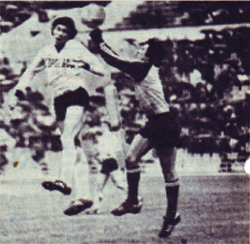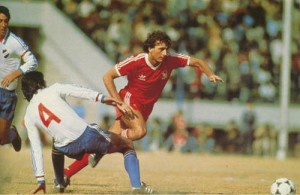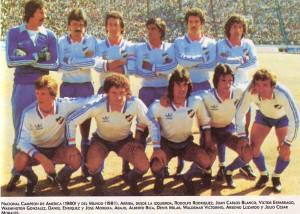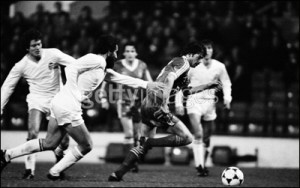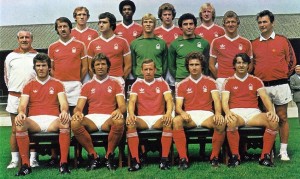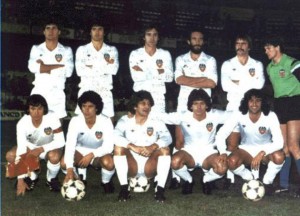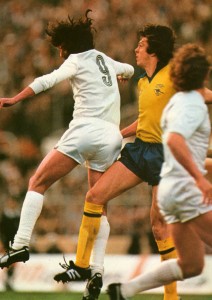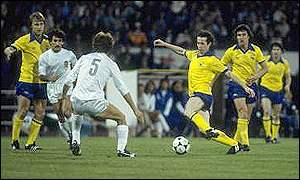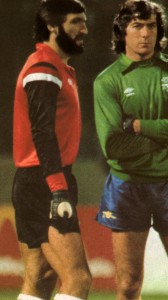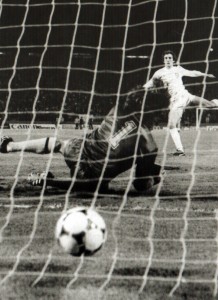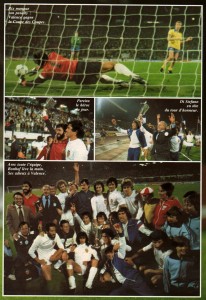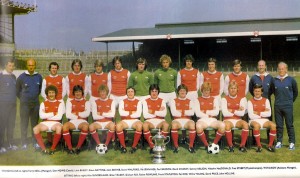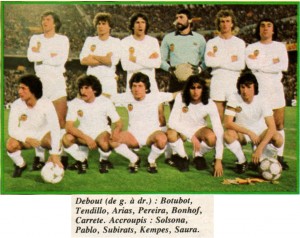The European Champions Cup was similar to the other continental tournaments this season – there were no hard draws and therefore few upsets. Perhaps the only real surprise happened in the first round, when Liverpool was eliminated by Dinamo (Tbilisi). Liverpool won at home 2-1, which looked like temporary carelessness, but in Tbilisi practically destroyed arguably the best team at the time – 3-0. The outcome appeared strange, but let’s face it: Dinamo (Tbilisi) had great team at its peak. The other surprise was FC Porto – they eliminated AC Milan in the first round after 0-0 in Porto and away victory 1-0 in Milano. 1979-80 international season was perhaps the lowest point Italian football reached in the 1970s: only Juventus managed to reach the semi-finals and even they were shaky on the way. On the other hand, FC Porto was beginning its own ascent, eventually becoming one of the leading European clubs by mid-80s. The last note on the start of the tournament was political: the second leg of the preliminary draw between Dundalk (Republic of Ireland) and Linfield (Northern Ireland) was played in Haarlem (Holland). Because of the struggle between IRA and British armed forces, Northern Ireland was banned from hosting international marches – terrorism was the reason.
Nothing unusual happened in the second round: Dinamo (Tbilisi) lost to Hamburger SV both legs – 1-3 and 2-3. FC Porto lost to Real Madrid because of away goal – 1-0 and 1-2. At the ¼ finals there was no way preventing bigger clashes, but there was only one – Celtic vs Real Madrid. Celtic won at home 2-0, then lost in Madrid 0-3 and Real went ahead. Hard to be sorry for the Scots: objectively, Real were the stronger team at the moment. Thus, no surprises once again – Hajduk (Split) tried hard, but at the end lost to Hamburger SV, however, minimally: the Germans won 1-0 at home and lost 2-3 in Split, but qualified thanks to their away goals.
The draw for the ½ benefited Nottingham Forest. Real Madrid and Hamburger SV were paired together and Ajax was left for Nottingham. On the surface, it was not an easy confrontation: it looked like Ajax was coming back. They were the highest scoring team so far – all together, they put the ball in the net 30 times, winning 8-1 twice, 10-0 once, and 4-0 once. Wishful thinking… so far, Ajax had the easiest possible opponents: HJK Helsinki in the first round, then Omonia (Cyprus) in the second round, and RC Strasbourg in the third round. No wonder the Dutch scored so many goals and sailed easily ahead. So easily, they practically did not play the second leg against Omonia – after winning 10-0 at home, the away match was not important at all and Ajax lost it 0-4. It was telling loss – the great Ajax of the early 70s did not allow such losses: even when they played leisurely, they were still far stronger than the opposition, especially such weak one as Omonia. Yet, even if the new Ajax was not equal to the old one, ambition was driving motivator and they tried to reach the final. Nottingham got 2-0 advantage at home, Ajax pushed at the second leg, but Nottingham’s defense allowed only one goal. Close, but Nottingham were the final winners.
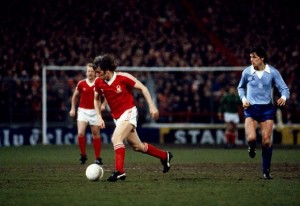 Moments from the opening match in Nottingham: Ajax in unusual colours, looking rather ordinary. In the great years, it was the opposition looking helpless and left left behind. Now it was Ajax.
Moments from the opening match in Nottingham: Ajax in unusual colours, looking rather ordinary. In the great years, it was the opposition looking helpless and left left behind. Now it was Ajax.
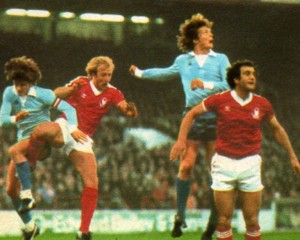 Ajax fought, yet… what a difference: Ruud Krol, the last of the great flying Dutchmen still playing for Ajax, just struggles at the far left. In the memorable past he was soaring high, dominating the game. Times changed.
Ajax fought, yet… what a difference: Ruud Krol, the last of the great flying Dutchmen still playing for Ajax, just struggles at the far left. In the memorable past he was soaring high, dominating the game. Times changed.
The other semi-final repeated the first leg of Nottingham-Ajax: at home, Real Madrid won 2-0. Looked like strong advantage and since the final was to be played at Bernabeu Stadium, Real was seen not only as finalist, but as Cup winner. The Germans had different idea and they mercilessly destroyed Real in Hamburg 5-1. Desire, ambition, tradition, grit – nothing helped and Real bowed down to reality: German football ruled.
Nottingham Forest vs Hamburger SV. Exciting final – current Cup holders vs bright ambitious team. West Germans vs English – the leading forces in club football. A plethora of top international players, with Kevin Keegan on top of the list. The Englsih best player against… well, a bunch of Scots and Irish? Something like that, but incredibly intriguing. Trevor Francis missed the final. Horst Hrubesch was on the bench.
Final, Bernabeu Stadium, Madrid, 28 May 1980, att 50000
Nottingham Forest (1) 1 Hamburger SV (0) 0
21′ 1-0 N: Robertson
Nottingham Forest (trainer Clough)
Shilton; Anderson, Gray (Gunn), Lloyd, Burns, Clark; O’Neill, McGovern, Bowyer, Mills (O’Hare), Robertson; Birtles
Hamburger SV (trainer Zebec)
Kargus; Kaltz, Nogly, Buljan, Jakobs; Hieronymus (Hrubesch), Magath, Memering; Keegan, Reimann, Milewski
Referee: Da Silva Garrido (Portugal)
The final was mor exciting on paper than of the pitch – the battle was hard fought, but it was mostly a battle. The Germans never shied away from a clash, and Nottingham was different from was expected from English team: Brian Clough, well aware of the limitations of his squad, preferred tied, defensive tactics. Without Trevor Francis, his attacking options were fewer anyway and the tactical difference was clear: Branko Zebec used the typical scheme of the time – 4-3-3. Clough used seemingly outdated Italian scheme – 5-4-1. Gary Birtles was the lone striker – facing defensive line, lead by Kaltz and Buljan. Rapidly rising to international fame Magath lead the German midfield, which looked superior to Nottingham’s, and finally the German strikers, lead by Keegan, seemed much better than the Nottingham’s defenders. At a glance, Nottingham had only stronger goalkeeper. On the pitch, nobody really prevailed – the final was very exciting to watch, but Clough’s players delivered what they were asked to do and eventually scored a goal in the 21st minute. The only goal of the match.
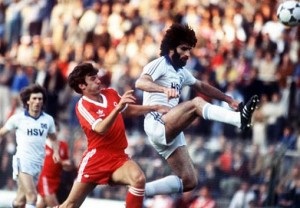 Ivan Buljan unquestionably dominates Gary Birtles.
Ivan Buljan unquestionably dominates Gary Birtles.
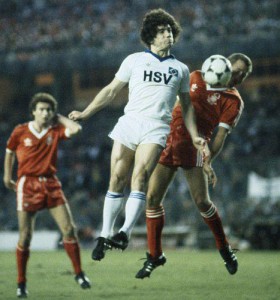 Kevin Keegan effortlessly wins the battle with bigger English defender. The pictures tells about German superiority… But Nottingham scored and Hamburger SV did not and Nottingham Forest won their second Champions Cup in a row.
Kevin Keegan effortlessly wins the battle with bigger English defender. The pictures tells about German superiority… But Nottingham scored and Hamburger SV did not and Nottingham Forest won their second Champions Cup in a row.
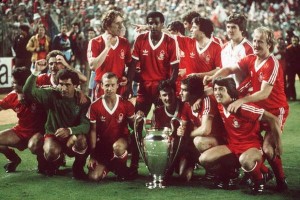 Happy winners indeed. Standing from left: Martin O’Neill, Ian Bowyer, Viv Anderson, John Robertson, Gary Mills, Kenny Burns.
Happy winners indeed. Standing from left: Martin O’Neill, Ian Bowyer, Viv Anderson, John Robertson, Gary Mills, Kenny Burns.
Crouching: Frank Gray, Peter Shilton, John McGovern, Garry Birtles, Larry Lloyd, Brinley Gunn.
John O’Hare is missing. And Brian Clough.
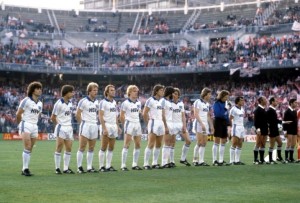 Hamburger SV at the beginning of the final: form left – Keegan, Milewski, Memering, Reimann, Hieronymus, Nogly, Buljan, Jakobs, Kaltz, Kargus, Magath. Almost there, close to the top, but unable to conquer it yet. Still a little bit missing to become truly great team. It was a shame Hamburger SV was unable to shine with Kevin Keegan – but may be that was the reason: so far the make-up of HSV was forced: a cluster of veterans, who achieved almost nothing in their best years (Memering, Reimann, Nogly), one German superstar (Kaltz), two imported players, perhaps slightly beyond their peak (Keegan and Buljan), a strong, but hardly the best German keeper of the time (Kargus), rapidly becoming the top German midfielder of the period (Magath), and few up and coming players, who were primarily supporting players (Jakobs, Hieronymus, Milewski). Horst Hrubesch on the bench. Hrubesch and Magath truly established themselves a bit later, after the final – at the European championship. So far, the idea was seemingly to built a strong squad, bringing stars from abroad – it worked to a point: Hamburger SV was strong, but not peaking yet. It still needed a few adjustments to become a great squad. It was not here time yet – and lost the final.
Hamburger SV at the beginning of the final: form left – Keegan, Milewski, Memering, Reimann, Hieronymus, Nogly, Buljan, Jakobs, Kaltz, Kargus, Magath. Almost there, close to the top, but unable to conquer it yet. Still a little bit missing to become truly great team. It was a shame Hamburger SV was unable to shine with Kevin Keegan – but may be that was the reason: so far the make-up of HSV was forced: a cluster of veterans, who achieved almost nothing in their best years (Memering, Reimann, Nogly), one German superstar (Kaltz), two imported players, perhaps slightly beyond their peak (Keegan and Buljan), a strong, but hardly the best German keeper of the time (Kargus), rapidly becoming the top German midfielder of the period (Magath), and few up and coming players, who were primarily supporting players (Jakobs, Hieronymus, Milewski). Horst Hrubesch on the bench. Hrubesch and Magath truly established themselves a bit later, after the final – at the European championship. So far, the idea was seemingly to built a strong squad, bringing stars from abroad – it worked to a point: Hamburger SV was strong, but not peaking yet. It still needed a few adjustments to become a great squad. It was not here time yet – and lost the final.
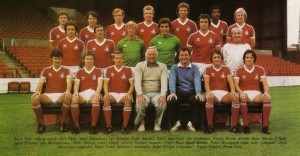 Nottingham Forest, arguably, at its best. Twice European champions already, winners of every trophy in the last two years. A legendary club already? Nottingham is perhaps the strangest winner – nobody denies the genius of Brian Clough. Nobody can say anything against players like Francis, Shilton, Anderson, Birtles. Yet, Nottingham remains a mythical club largely because they were the underdogs and not a great team. Certainly not great to watch – the least exciting of all English teams playing European finals. Even un-English, with its defensive tactics and generally boring kind of playing. And again – the make-up: Clough favoured second-raters and as great as it was to see ‘discarded’ players conquering Europe (O’Hare, Lloyd, Robertson, Burns), it was unconvincing squad, for it was impossible to see it getting better – rather, it was an accidentally winning team. True, Clough tried hard to elevate the quality, by signing classy stars like Shilton and Francis, but in the same time he was signing questionable for one or another reason players like Stan Bowles and Charlie George. He easily sold Tony Woodcock – but this was understandable, since the strikers at hand were quite similar. One thing was painfully clear already – Nottingham Forest was not going to become a dynasty. It looked largely a group of individual names, but not a real great team: motivation was going to work for a little while perhaps, but Clough’s unorthodox concepts prevented building of long-lasting and memorable team. The great days were rapidly coming to end… untypical team ended untypically: as Clough said later, the boys were no longer motivated after winning everything. There was nothing more to win, nothing more to prove… and started to lose. Boredom. Disinterest. Sounds intriguing – and nothing else. A great short run of ugly ducks. The only endearing thing about Nottingham is perhaps one more look at the names – practically everybody won their international trophies during this two years. Players, beyond their peak (O’Hare, Lloyd), middle of the road players (Robertson, Burns), mercurial talents, who failed to reach true success (Bowles, George, Bowyer), great stars, who just played most of the time for clubs in rougher shape and thus unable to win trophies (Francis, Shilton, Birtles, Anderson, Woodcock). It was good to see them win – especially those, who would never win again… the trophy-less superstars. Nottingham Forest – the strangest European conquerors of them all. Back in 1980 it was very possible they were going to win more cups: so unlikely winners they were that everything was possible. They were not fun to watch, though… welcome to the 1980s.
Nottingham Forest, arguably, at its best. Twice European champions already, winners of every trophy in the last two years. A legendary club already? Nottingham is perhaps the strangest winner – nobody denies the genius of Brian Clough. Nobody can say anything against players like Francis, Shilton, Anderson, Birtles. Yet, Nottingham remains a mythical club largely because they were the underdogs and not a great team. Certainly not great to watch – the least exciting of all English teams playing European finals. Even un-English, with its defensive tactics and generally boring kind of playing. And again – the make-up: Clough favoured second-raters and as great as it was to see ‘discarded’ players conquering Europe (O’Hare, Lloyd, Robertson, Burns), it was unconvincing squad, for it was impossible to see it getting better – rather, it was an accidentally winning team. True, Clough tried hard to elevate the quality, by signing classy stars like Shilton and Francis, but in the same time he was signing questionable for one or another reason players like Stan Bowles and Charlie George. He easily sold Tony Woodcock – but this was understandable, since the strikers at hand were quite similar. One thing was painfully clear already – Nottingham Forest was not going to become a dynasty. It looked largely a group of individual names, but not a real great team: motivation was going to work for a little while perhaps, but Clough’s unorthodox concepts prevented building of long-lasting and memorable team. The great days were rapidly coming to end… untypical team ended untypically: as Clough said later, the boys were no longer motivated after winning everything. There was nothing more to win, nothing more to prove… and started to lose. Boredom. Disinterest. Sounds intriguing – and nothing else. A great short run of ugly ducks. The only endearing thing about Nottingham is perhaps one more look at the names – practically everybody won their international trophies during this two years. Players, beyond their peak (O’Hare, Lloyd), middle of the road players (Robertson, Burns), mercurial talents, who failed to reach true success (Bowles, George, Bowyer), great stars, who just played most of the time for clubs in rougher shape and thus unable to win trophies (Francis, Shilton, Birtles, Anderson, Woodcock). It was good to see them win – especially those, who would never win again… the trophy-less superstars. Nottingham Forest – the strangest European conquerors of them all. Back in 1980 it was very possible they were going to win more cups: so unlikely winners they were that everything was possible. They were not fun to watch, though… welcome to the 1980s.
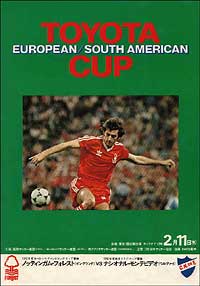 The greatest part of the crowd was Japanese, which created strange atmosphere: both teams were equally cheered by benevolent, yet, largely ignorant of football crowd. Winter football was generally benefiting the English, who played without winter break anyway. The South Americans saw themselves in disadvantage, but on the other hand the pitch was not exactly up to European standards and more familiar to the Uruguayans. May be so… both goalkeepers played with long trousers, instead of shorts,which was very unusual. The match itself was not so great – at first Nacional attacked and scored in the 10th minute.
The greatest part of the crowd was Japanese, which created strange atmosphere: both teams were equally cheered by benevolent, yet, largely ignorant of football crowd. Winter football was generally benefiting the English, who played without winter break anyway. The South Americans saw themselves in disadvantage, but on the other hand the pitch was not exactly up to European standards and more familiar to the Uruguayans. May be so… both goalkeepers played with long trousers, instead of shorts,which was very unusual. The match itself was not so great – at first Nacional attacked and scored in the 10th minute.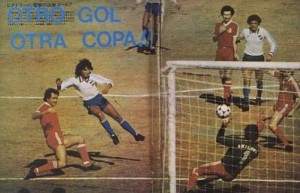 Waldemar Victorino scores an early goal. Looks like a header – something rare against English defense, if it was indeed a header.
Waldemar Victorino scores an early goal. Looks like a header – something rare against English defense, if it was indeed a header.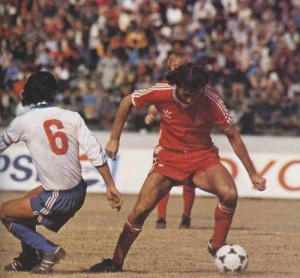 Seemingly the better team, Nottingham Forest lost 0-1.
Seemingly the better team, Nottingham Forest lost 0-1.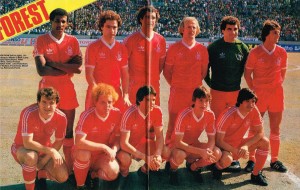 After losing the Supercup, Nottingham Forest lost a second international trophy. Not by much, but they lost. Standing from left: Viv Anderson, Martin O’Neill, Larry Lloyd, Kenny Burns, Peter Shilton, Trevor Francis.
After losing the Supercup, Nottingham Forest lost a second international trophy. Not by much, but they lost. Standing from left: Viv Anderson, Martin O’Neill, Larry Lloyd, Kenny Burns, Peter Shilton, Trevor Francis.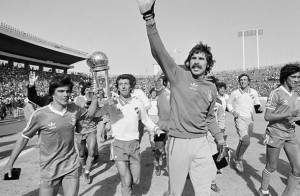 Nacional proudly displays the Toyota Cup in Tokyo.
Nacional proudly displays the Toyota Cup in Tokyo.